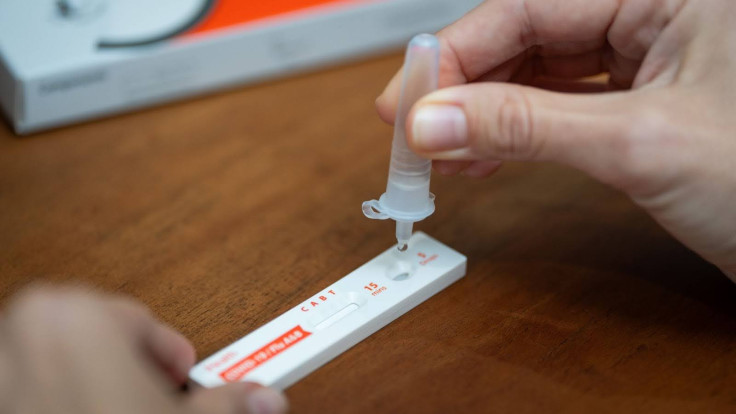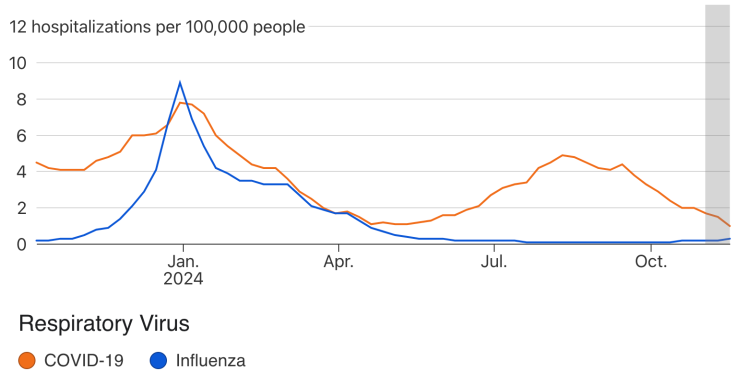Understanding The Differences Between The Flu And COVID-19
Learn about the causes and severity of these viruses and how to identify and treat their symptoms

As flu season begins and COVID-19 remains a concern, distinguishing between these two respiratory illnesses is more important than ever. Though both diseases share some symptoms, they are caused by distinct viruses, have varying levels of severity and respond to different treatments.
Understanding the difference between the flu and COVID-19 can help families make informed decisions about their health, especially during flu season when both viruses circulate.
What Causes the Flu and COVID-19?
The flu is caused by influenza viruses, typically Influenza A or Influenza B. These viruses have been circulating globally for centuries and most people have experienced at least one bout of flu in their lifetime.
COVID-19, on the other hand, is caused by the SARS-CoV-2 virus, a novel coronavirus that emerged in late 2019. Coronaviruses are a family of viruses that can cause respiratory illnesses ranging from the common cold to more severe diseases like SARS (Severe Acute Respiratory Syndrome) and MERS (Middle East Respiratory Syndrome).
Symptoms: Similarities and Differences
Since both the flu and COVID-19 are respiratory illnesses, they share several symptoms, making it difficult to tell them apart without testing. These common symptoms include:
- Fever or feeling feverish
- Cough
- Fatigue (tiredness)
- Sore throat
- Body aches or muscle pains
- Headache
- Runny or stuffy nose
- Shortness of breath (though more common in COVID-19)
While many symptoms are similar, some signs are more specific to one virus over the other.
Distinct COVID-19 Symptoms
- Loss of taste or smell (a hallmark of COVID-19; although it can occur with other respiratory infections, it's much more common with COVID-19).
- Diarrhea and nausea may also be more frequent in COVID-19 patients compared to those with the flu.
Distinct Flu Symptoms
- Flu symptoms tend to occur more suddenly than COVID-19 symptoms, which can develop more gradually.
Contagiousness and Spread
The flu and COVID-19 spread through respiratory droplets when an infected person coughs, sneezes, talks or breathes. Both viruses can also spread by touching surfaces contaminated with the virus and then touching the mouth, nose or eyes.
Flu transmission. The flu has circulated in human populations for centuries and its transmission patterns are well-understood. Flu season typically peaks during the colder months. People can spread the virus one day before symptoms appear and for about five to seven days afterward.
COVID-19 transmission. COVID-19 spreads more easily than the flu. In addition to respiratory droplets, the SARS-CoV-2 virus can spread via airborne transmission, which can linger in the air for extended periods, particularly in poorly ventilated indoor spaces. Additionally, COVID-19 can be spread by asymptomatic carriers—people who do not exhibit symptoms but are still contagious. This makes controlling the spread of COVID-19 more challenging.
Severity and Complications
The flu and COVID-19 can range from mild to severe, but COVID-19 has shown a higher tendency to cause severe illness, particularly in vulnerable populations. Here are the differences in severity and potential complications:
Flu severity. For most people, the flu causes moderate illness, with recovery occurring within one to two weeks. However, in some cases, especially in young children, the elderly and those with weakened immune systems, the flu can lead to complications like pneumonia, bronchitis, sinus infections and exacerbation of chronic illnesses like asthma or heart disease.
COVID-19 severity. COVID-19 can lead to severe complications more frequently than the flu, especially in older adults, those with underlying health conditions, and the immunocompromised. Common severe outcomes include acute respiratory distress syndrome (ARDS), blood clots, multisystem inflammatory syndrome (particularly in children), long COVID (persistent symptoms)and organ damage, particularly to the heart and lungs.


To-date, more than 95 million people have had COVID-19 in the U.S., according to the Centers for Disease Control and Prevention (CDC). More than 1 million people have died of COVID-19 in the U.S.
By comparison, during the 2021-2022 flu season in the U.S., between 8 and 13 million people had the flu and between 5,000 and 14,000 people died.
Diagnosis: How to Tell the Difference
Given the overlapping symptoms of the flu and COVID-19, a clinical diagnosis often isn't enough to tell which virus is responsible for your illness. Fortunately, there are tests for flu and COVID-19 that can even be administered at home.
Combination rapid flu and COVID-19 antigen tests, like iHealth's COVID-19/Flu A&B 3-in-1 Rapid Test, are widely available and provide results within 15 minutes.
Different Treatments for Different Viruses
Testing for the flu and COVID-19 within the first 48 hours of symptoms is critical for determining recovery times if you test positive.
According to the CDC, for more severe cases of the flu, over-the-counter and FDA-approved prescribed medicines can be taken to alleviate flu symptoms, make the illness less severe and reduce the risk of complications. Early detection shortens the duration of illness by 1-2 days.
Antiviral drugs, like Remdesivir and Paxlovid, reduce the severity of COVID-19 when taken within the first 5 days of a positive test. Clinical trials using Remdesivir show a reduction in COVID-19 median recovery time from 15 to 10 days. Clinical trials using Paxlovid show symptom resolution can occur in 5 days for mild to moderate cases.
Testing: The Only Way to Be Sure
With overlapping symptoms, testing is the only definitive way to determine whether someone has the flu or COVID-19. Testing is critical in determining the correct treatment, as some therapies are effective if taken early. Understanding the key differences in symptoms, severity, contagiousness and treatment options can help families make informed decisions about their health.
****
Binit Shah is a content writer and senior marketing specialist for iHealth Labs. With over a decade of experience writing about healthcare and science industries, he aims to make complex issues accessible to readers. Binit enjoys exploring the intersection of human interests and technology.
© Copyright IBTimes 2024. All rights reserved.





















